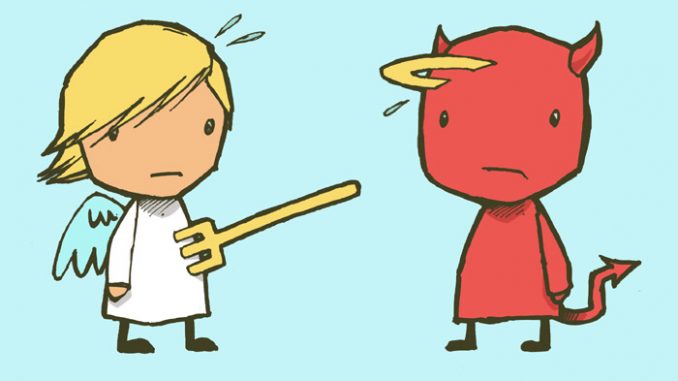
Alexandria LaFlair, Staff Writer |
We’ve all watched Stars Wars, in which the antagonist is Darth Vader. We have all heard of Cruella de Vil and her plan for the Dalmatians. We see the stories on news channels of mass shooters and family members stabbing one another over trivial things, such as money. But do we really know what evil is? Where does evil stem from? Is it an objective standard or a character trait?
Since the dawn of time, “good vs. evil” has been a prevalent theme in the human condition and narrative. Characteristics of evil were largely defined by religion, and the study of evil grew during the Enlightenment. In Randolph Trumbach’s novel “Sex and the Gender Revolution,” he focuses on how promiscuous women were viewed as evil, as it was believed they that were solely created to give birth and raise children rather than desire sex for personal pleasure. As feminism grew as a study and a major movement, the targets of Americans’ perception of evil shifted to African-Americans and homosexual people.
Jennifer Dumin’s article in Wisconsin’s Women’s Law Journal hones in on people’s past belief that black women were witches and that homosexuals were dividing the country with “their HIV/AIDS and disintegration of the traditional family.” Even today, we can see targets of hate who are scapegoated as the root of “evil.”
But what is evil? What gives someone the authority to define evil?
Merriam-Webster describes evil as “morally reprehensible; causing discomfort or repulsion; causing harm.”
In those terms, pickles are evil. An ex can be considered an evil person.
Scholars argue that the concept of evil is often associated with what causes people deep mental, emotional, or physical pain.
J.L. Mackie related this topic back to religion, stating “God is wholly good; yet evil exists.”
Religions such as Christianity personify these concepts in a good God and a Devil, who is the producer of evil acts.
N. T. Wright’s novel “Evil and the Justice of God” reflects on major natural disasters and terrorist attacks done for religious purposes, asking why these events continue to occur when people consistently pray and give themselves over to God.
This complex discussion may never have a proven answer or complete theory. My take on the topic is that an individual’s perception of evil comes from their religious point of view and their emotions, which are very much based on childhood experiences. People want to believe in and be a part of something bigger than themselves; religion can be a convenient source of comfort in that it gives a standard of good and evil, which people can use and interpret for better or worse.
“Intellect, the Emotions, and the Moral Nature” stresses the importance of emotions in regards to one’s perception of evil, evil acts, and evil thoughts. Those can be related to one’s childhood, whether it was a so-called “fulfilling,” “easy” childhood or a troublesome childhood.
Through these vague theories, we cannot escape the fact that evil has always existed and always will. There will always be someone in opposition of what people define as “good,” and there will always be people willing to go to any lengths to perpetuate their beliefs. Hopefully, society can continue to combat evil with moral and logical education.
Leave a Reply